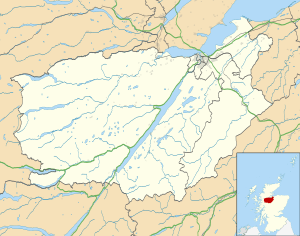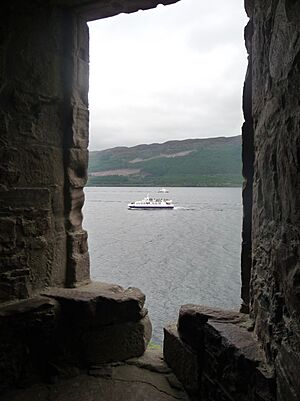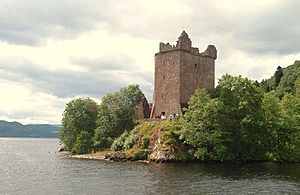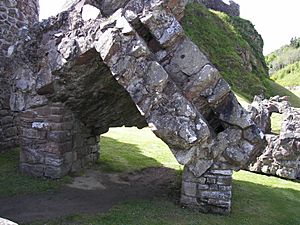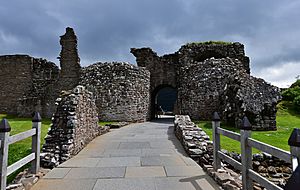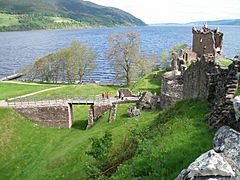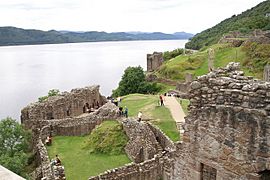Urquhart Castle facts for kids
Quick facts for kids Urquhart Castle |
|
|---|---|
| Near Drumnadrochit, Highland, Scotland | |

Urquhart Castle and Loch Ness
|
|
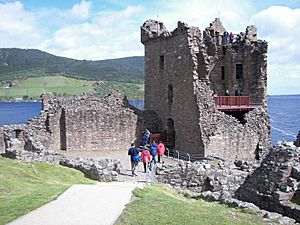
Urquhart Castle, Grant Tower
|
|
| Coordinates | 57°19′26″N 4°26′31″W / 57.324°N 4.442°W |
| Type | Curtain wall castle and tower house |
| Site information | |
| Owner | Historic Environment Scotland |
| Open to the public |
Yes |
| Condition | Ruined |
| Site history | |
| Built | 13th to 16th centuries |
| In use | Until c. 1692 |
Urquhart Castle (pronounced UR-kert) is a castle in ruins located next to Loch Ness in the Highlands of Scotland. You can find it on the A82 road, about 21 kilometers (13 miles) southwest of Inverness and 2 kilometers (1.25 miles) east of Drumnadrochit.
The castle you see today was mostly built between the 13th and 16th centuries. However, there was an even older fort on this spot from the early Middle Ages. Urquhart Castle was very important during the Wars of Scottish Independence in the 1300s. It was a royal castle, meaning it belonged to the king, and was often attacked by the powerful MacDonald Earls of Ross. In 1509, the castle was given to the Clan Grant, a Scottish family, but the fights with the MacDonalds continued.
Even after many attacks, the castle was made stronger. But by the mid-1600s, it was mostly left empty. In 1692, parts of Urquhart Castle were destroyed on purpose to stop Jacobite soldiers (who supported the old king) from using it. After that, the castle slowly fell apart. In the 1900s, it became a protected site and was opened to visitors. Today, Urquhart Castle is one of Scotland's most popular castles, with over half a million visitors in 2019.
The castle sits on a piece of land that sticks out into Loch Ness. It's one of the biggest castles in Scotland. To get in, you would cross a ditch and a drawbridge from the west. The castle buildings are spread out in two main areas along the loch shore. The northern area, called the Nether Bailey, has most of the parts that are still standing, including the entrance gate and the five-story Grant Tower. The southern area, called the Upper Bailey, is on higher ground and has the remains of older buildings.
Contents
Castle History: A Timeline
Ancient Beginnings: What Was Here Before?
The name Urquhart comes from old words meaning "point" or "promontory" and "thicket" or "wood." Scientists found special "vitrified" stones at Urquhart. These stones were heated so much they turned into a glassy material, which was common in early forts.
Some people thought Urquhart might have been the fort of Bridei, a king of the northern Picts (an ancient Scottish people) in the 500s. A book called Life of Columba says that Saint Columba visited King Bridei and also met a nobleman named Emchath at a place called Airdchartdan. Digs in 1983 showed that the rocky hill at the castle's southwest corner was indeed a large fort between the 400s and 1000s. This means Urquhart was likely Emchath's home, not King Bridei's.
Building the First Castle: The Early Years
Some stories say that William the Lion, a Scottish king, had a castle here in the 1100s, but there's no real proof. In the 1100s and 1200s, a family called the Meic Uilleim (MacWilliams) rebelled against the Scottish kings. After their last rebellion was stopped in 1229, King Alexander II gave Urquhart to his officer, Thomas de Lundin.
When Thomas died, the land went to his son, Alan Durward. It's believed that the first castle was built around this time. It was centered on a small hill called a motte at the southwest part of the site. In 1275, after Alan's death, the king gave Urquhart to John II Comyn, Lord of Badenoch.
Wars for Independence: Fighting for Scotland
The first time Urquhart Castle is mentioned in official papers is in 1296. This was when Edward I of England captured it. Edward's invasion started the Wars of Scottish Independence, which were battles that lasted until 1357. Edward put Sir William Fitz Warin in charge of the castle for the English.
In 1297, a Scottish leader named Sir Andrew de Moray attacked Fitz Warin and then tried to capture the castle, but he failed. The Scots must have taken it back soon after, because in 1298, Urquhart was controlled by the Scots again. In 1303, another English attack succeeded. This time, Edward put Alexander Comyn in charge, as his family was on the English side.
After Robert Bruce defeated the Comyn family in 1307, he marched through the Great Glen and took Urquhart, along with other castles. From then on, Urquhart became a royal castle, held by different people for the king.
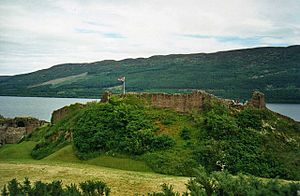
Sir Robert Lauder of Quarrelwood was in charge of Urquhart Castle in 1329. After a big battle in 1333 where the Scots lost, Lauder returned to defend Urquhart from another English invasion. It was one of only five castles in Scotland that the Scots still held at that time. In 1342, King David II spent the summer hunting at Urquhart. He was the only king to ever stay there.
MacDonald Raids: Lords of the Isles Attack
For the next 200 years, the MacDonald Lords of the Isles often raided the Great Glen. These powerful leaders ruled a separate kingdom in western Scotland. In 1395, Domhnall of Islay took Urquhart Castle from the king and kept it for over 15 years.
In 1411, Domhnall marched through the glen to claim the earldom of Ross. He won a battle and kept control of Ross. Later, King James I recognized his claim. But the Scottish king soon got Urquhart back.
In 1437, Domhnall's son Alexander, Earl of Ross, attacked the area around Glen Urquhart but couldn't take the castle. The king then sent money to make the castle's defenses stronger. Alexander's son John became Earl in 1449. In 1452, he also led a raid, took Urquhart, and was even given the castle and lands for life.
However, in 1462, John made a secret deal with the English king against the Scottish King James III. When King James found out in 1476, John lost his titles, and Urquhart was given to an ally, the Earl of Huntly.
The Grant Family: New Owners, More Fights
The Earl of Huntly brought in Sir Duncan Grant to bring order to the area around Urquhart Castle. In 1509, King James IV gave Urquhart Castle and the nearby lands to John Grant forever, as long as he fixed and rebuilt the castle. The Grants owned the castle, but attacks from the west continued.
In 1513, after a big battle where Scotland lost many soldiers, Sir Donald MacDonald of Lochalsh tried to take advantage of the chaos. He claimed the Lordship of the Isles and took Urquhart Castle. The Grants got the castle back before 1517, but not before the MacDonalds stole 300 cattle, 1,000 sheep, and everything valuable from the castle.
In 1545, the MacDonalds and their allies, the Camerons, attacked and captured Urquhart again. This was called the "Great Raid." This time, they took 2,000 cattle, hundreds of other animals, and even the castle's furniture, cannons, and gates! The Grants eventually got the castle back and were given some Cameron lands as payment.
The Great Raid was the last major attack. By the late 1500s, the Grants had rebuilt Urquhart, and they became a powerful family in the Highlands. Repairs continued until 1623, but the castle was no longer their main home. In 1644, a group of Covenanters (Presbyterian activists) broke into the castle, robbed Lady Mary Grant, and forced her out because of her religious beliefs. An inventory in 1647 showed the castle was almost empty.
When King James VII was removed from power in 1688, Ludovic Grant sided with William of Orange and put 200 of his own soldiers in the castle. Even without many weapons, they had plenty of food. When 500 Jacobites (supporters of the old king) tried to take the castle, the soldiers held out until the Jacobites were defeated in May 1690. When the soldiers finally left, they blew up the gatehouse to stop the Jacobites from using the castle. You can still see large pieces of fallen stone near the gatehouse today.
Urquhart Today: A Ruin and a Tourist Spot
By the 1770s, the castle had no roof and was seen as a beautiful ruin by artists and visitors. In 1911, the castle was given to the Scottish government to look after. Historic Environment Scotland (which used to be Historic Scotland) still takes care of the castle today. It's a protected site because of its national importance.
In 1994, Historic Scotland planned to build a new visitor center and parking area. After some debate, the plans were approved in 1998. The new building is built into the hillside, with parking on its roof. The visitor center has displays about the castle's history, a movie, a restaurant, and a shop. The castle is open all year and even hosts weddings. In 2018, over 500,000 people visited Urquhart Castle, making it one of Scotland's most popular attractions.
What Does Urquhart Castle Look Like?
Urquhart Castle is built on Strone Point, a triangular piece of land on the northwest shore of Loch Ness. It controls the path along the loch and the entrance to Glen Urquhart. The castle is quite close to the water, with low cliffs on the northeast sides. On the land side, there was once a "castle-town" with service buildings, gardens, and orchards.
A dry ditch, 30 meters (98 feet) wide, protects the castle from the land. A stone path leads to the castle, with a drawbridge that used to cross the ditch. The castle side of the path was once walled, creating a protected entrance.
Urquhart is one of the biggest castles in Scotland by area. The walled part of the castle looks a bit like a figure-8 shape, about 150 by 46 meters (492 by 151 feet). It has two main areas: the Nether Bailey to the north and the Upper Bailey to the south. The main walls of both areas were built in the 1300s, but many parts were added later, especially in the north where most of the remaining buildings are.
The Nether Bailey: Main Castle Area
The gatehouse, built in the 1500s, is on the land side of the Nether Bailey. It has two D-shaped towers on either side of an arched entrance. The entrance used to have a portcullis (a heavy gate that drops down) and two sets of doors, with guard rooms on each side. Above the entrance were rooms, possibly for the castle's keeper. Broken stones from when the gatehouse was destroyed after 1690 are still around.
The Nether Bailey was the busiest part of the castle after 1400. At its northern end is the Grant Tower, which was the main tower house or keep. The tower is 12 by 11 meters (39 by 36 feet) and has walls up to 3 meters (10 feet) thick. It stands on foundations from the 1300s but was mostly rebuilt in the 1500s. It used to have five stories and is still the tallest part of the castle, even though its southern wall fell in a storm in the early 1700s.
The top corners of the tower had small turrets. Above the main door on the west and a smaller back door on the east, there were "machicolations." These were narrow openings through which defenders could drop things on attackers. The western door also had its own ditch and drawbridge. You can still go inside the tower using the circular staircase built into the east wall. The first floor would have been a large hall, with more rooms above. The rooms on the main floors have big windows from the 1500s, but also small holes below them for pistols, for defense.
South of the tower are buildings built against the thick, supported wall from the 1300s. The great hall was in the middle of these buildings. The lord's private rooms were to the north, and the kitchens were to the south. The foundations of a rectangular building in the Nether Bailey are thought to be a chapel.
The Upper Bailey: Older Parts of the Castle
The Upper Bailey is centered on the rocky hill at the southwest corner of the castle. This was the highest part of the land and where the earliest defenses at Urquhart were built. Scientists found vitrified material here, showing it was the site of the early fort.
In the 1200s, this hill became the motte (a raised mound) of the first castle. The walls that remain today are part of a "shell keep" (a hollow enclosure) from that time. These ruins are broken, but they show there were towers to the north and south of the shell keep.
A watergate from the 1500s in the eastern wall of the Upper Bailey leads to the loch shore. The buildings next to it might have been stables. South of this, across from the motte, are the base of a doocot (a pigeon house) and the few remains of 13th-century buildings. These might have been a great hall but were later used as a smithy (a place where metal is worked).
Castle Treasures: What Was Found?
After the castle became public property, repairs and digs were done. These were stopped by World War I but finished by 1922. Many old items were found, including a bronze jug from the 1400s, coins, jewelry, crosses, and other things from the 1200s to the 1600s. Most of these valuable items are now kept at the National Museum in Edinburgh.
See also
 In Spanish: Castillo de Urquhart para niños
In Spanish: Castillo de Urquhart para niños


